Between the two trips, I got a remarkable number of images and video clips, which has taken no small amount of time to sort, resize, and/or edit into finished video – there’s one included here, and at least two more waiting in the wings. I will apologize in advance for the instability of the segments therein, since the visits to the refuge were as time allowed and I never planned on doing any specific shooting; it was only through finding so many subjects that video became a necessity. Add in that nearly everything had to be shot from the car (I cheated a little, and you’ll know where and why,) without any decent method of stabilizing a long lens out the car window. Between the two trips, I ordered a car-window mount, but it failed to arrive in time for the second trip and is, in fact, still caught in the USPS black hole that is the Greensboro Distribution Center, a bastion of managerial incompetence and negligence that remains unparalleled (and somehow ignored by the Inspector General, so add them to the incompetence list.) The thing is, there really aren’t that many opportunities to use a car window mount around here, so it may sit on a shelf for a long time, but on the trip when it would have been most useful, I didn’t have it.
Anyway, we’ll start with the video, shot entirely at the Montezuma National Wildlife Refuge – I have to admit, I never saw anywhere near this number of species while living only a few kilometers away, and not even on previous trips. Even more will show up in the still photos further below.
Let’s do this in the same order that they appeared, shall we?

This one was almost planned, as I progressed along the drive and wondered how well they would line up as I drew abreast of them. Pretty damn well, I have to admit, though that one in the foreground is the slacker that’s gonna let the invaders through the perimeter.

Great blue herons (Ardea herodias,) of course. This one was really intent on its preening – must’ve had a hot date (I did say it was breeding season.)
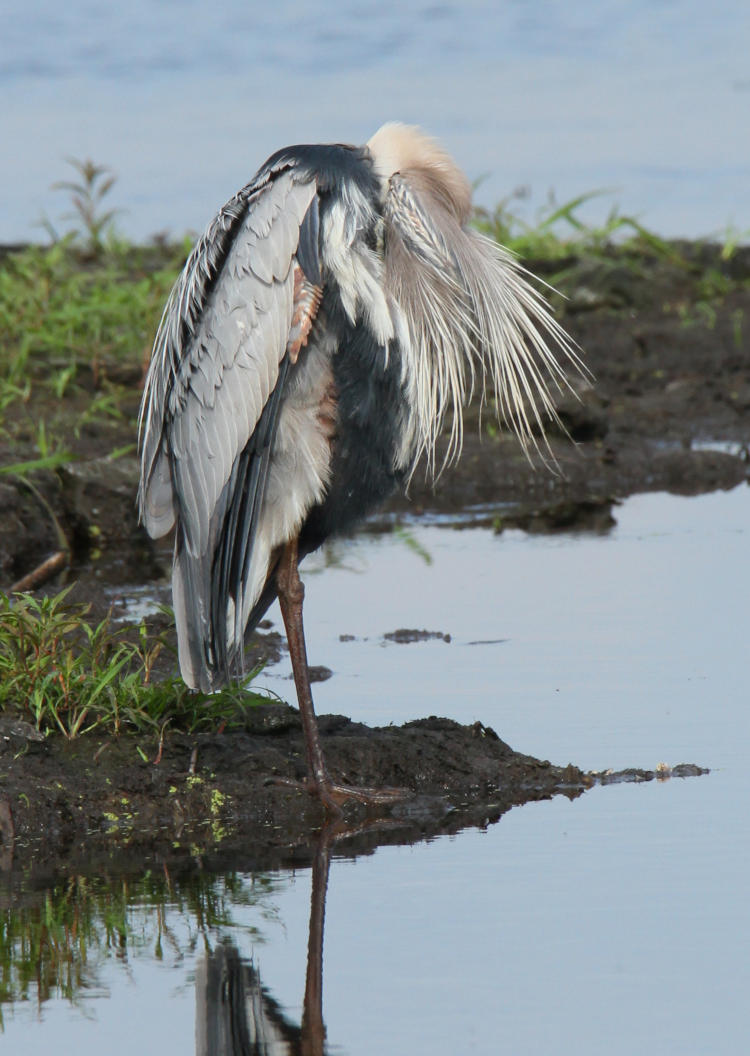
I was watching this take place, and still can’t figure out the position of its neck and head – I think it’s arched back a bit. If I’d made a loud noise right here it probably would have sprained something.
On another visit, one was doing its best to resemble a pole, though for what purpose I cannot offer an opinion.
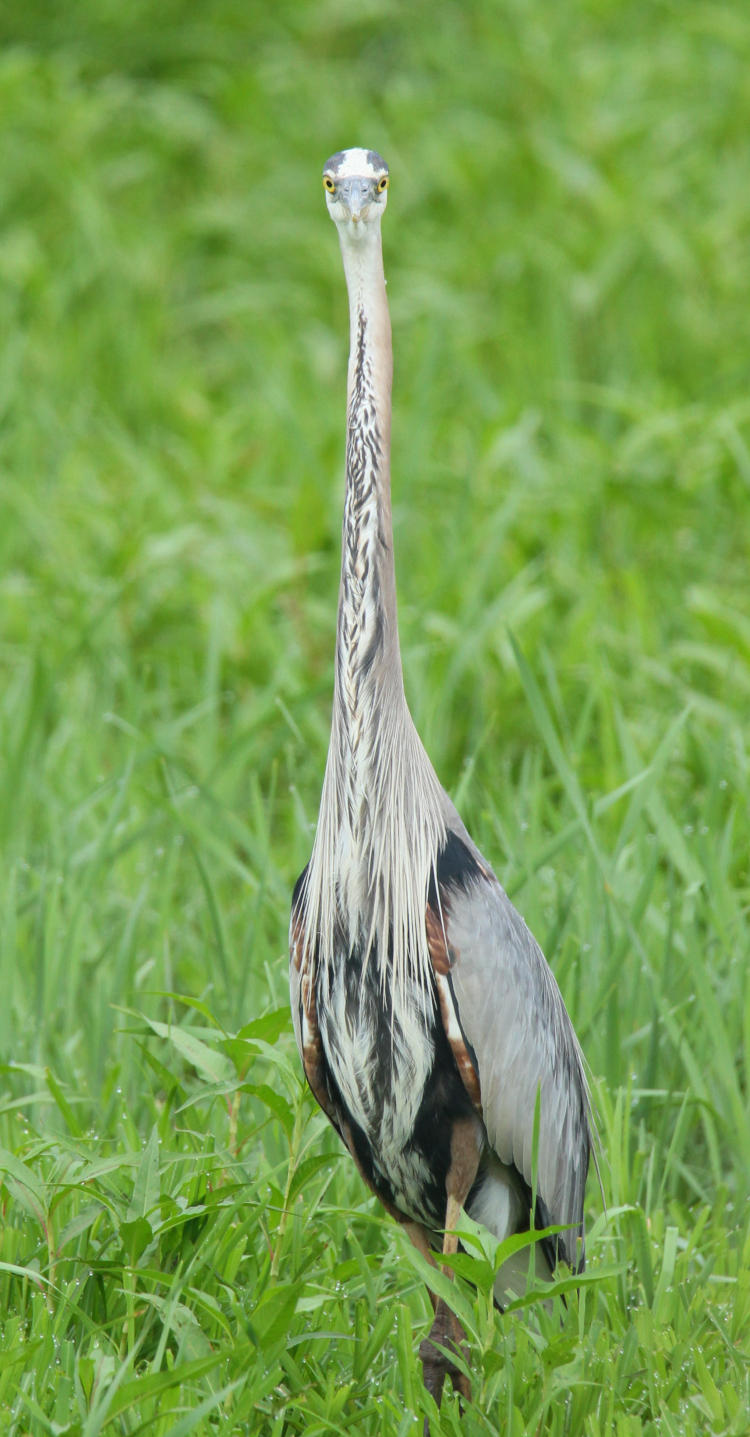
I couldn’t resist the intent look here, though within a few moments, it relaxed and stalked down towards the water, offering something even more expressive.

It would be easy to believe that someone was in trouble here, but that’s entirely misleading – as far as I can tell, the heron was simply yawning as it ambled down to the water for a snack. But yeah, this invites all sorts of interpretations, doesn’t it?
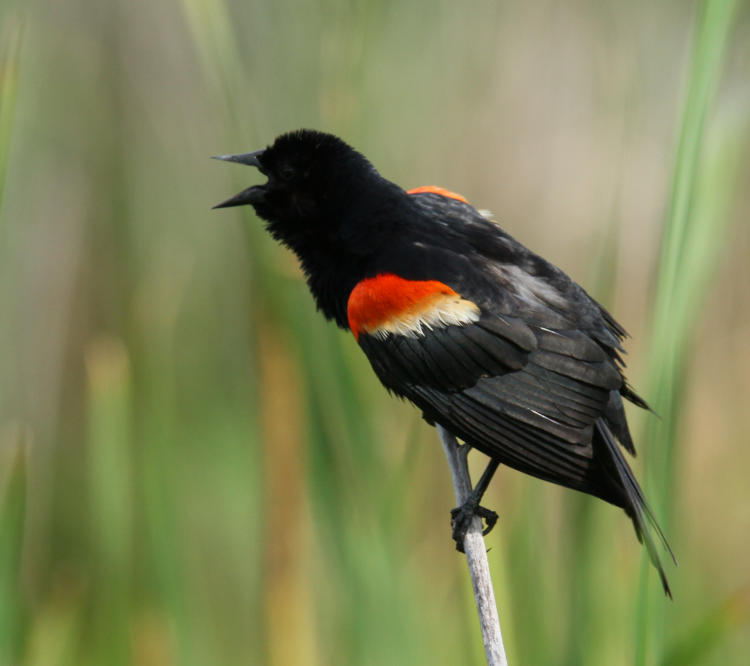
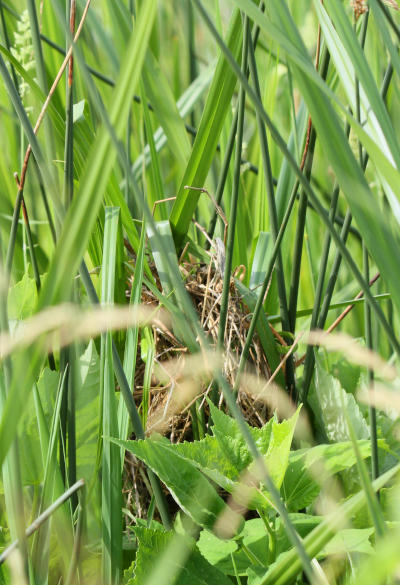 The male red-winged blackbird (Agelaius phoeniceus) sports the distinctive coloration, which it purposefully puffs erect when calling, and I’m willing to bet that those feathers also have a decent response in ultra-violet, which many birds can see – some birds, at least, have many times the color distinguishing ability in their eyes than we do. It also serves the purpose of, when predators draw close to the nest suspended in the reeds or grasses, drawing their attention as the male flies off, leaving the well-camouflaged female hidden on the nest. And it occurred to me as I typed this that I’d gotten a photo of a nest, but hadn’t edited it for posting, and so had to dig it out and get it in here (to the right now,) adding yet another photo to a post which promises to be absolutely overloaded with them. Ah well.
The male red-winged blackbird (Agelaius phoeniceus) sports the distinctive coloration, which it purposefully puffs erect when calling, and I’m willing to bet that those feathers also have a decent response in ultra-violet, which many birds can see – some birds, at least, have many times the color distinguishing ability in their eyes than we do. It also serves the purpose of, when predators draw close to the nest suspended in the reeds or grasses, drawing their attention as the male flies off, leaving the well-camouflaged female hidden on the nest. And it occurred to me as I typed this that I’d gotten a photo of a nest, but hadn’t edited it for posting, and so had to dig it out and get it in here (to the right now,) adding yet another photo to a post which promises to be absolutely overloaded with them. Ah well.
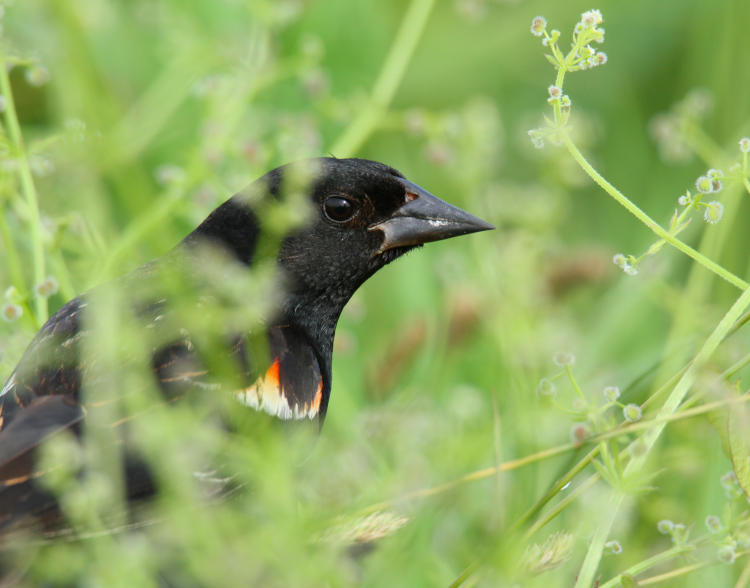
The very first day I visited was, apparently, peak breeding activity, and the birds were abundant and noisy, and not too concerned with the presence of the car or the long lens, as we can see here. There’s even a hint of the deep brown iris in there – the light conditions were perfect this particular day.

The same may be said for this eastern kingbird (Tyrannus tyrannus,) pausing after doing many frenzied circuits above a still pool in its quest for insects. We’ll see more of them shortly.
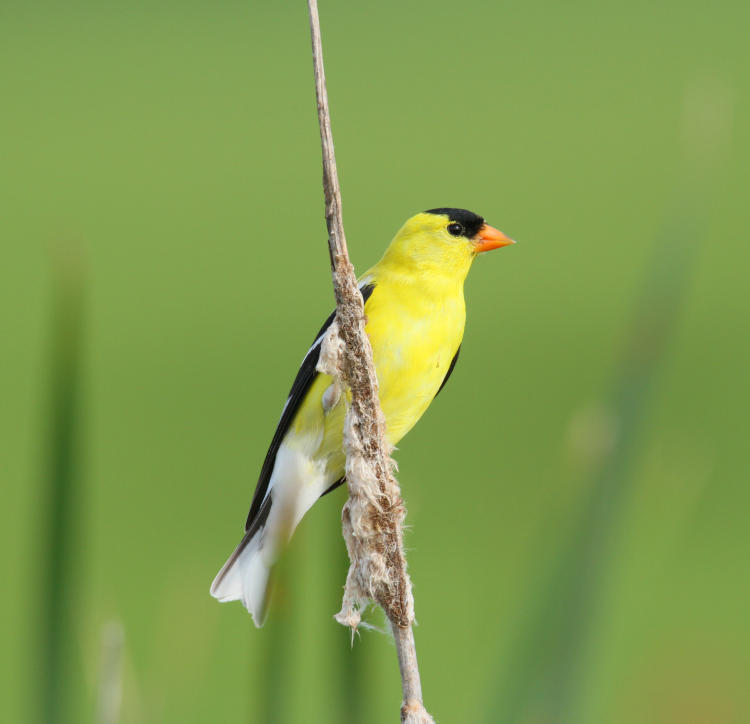
And a basic pose from the American goldfinch (Spinus tristis) – I got a few still frames on the yellow flowers with the fluffy seeds, but they’re not as sharp as this one. The refuge really does allow them to be much more acclimated to close approaches, at least within a car, than virtually anywhere else, so tight shots were much easier.
To a degree, anyway.

The roseate spoonbill (Platalea ajaja) was found on the second trip, spotted in the distance by The Girlfriend, and the hint of pink made me think ‘flamingo’ until I got the long lens on it – no wonder a line of cars was parked right there. I think I’ve photographed them only once, in Merritt Island National Wildlife Refuge in Cape Canaveral, Florida. It certainly seemed to be making the most of it, though how much food it was actually finding, I can’t say.
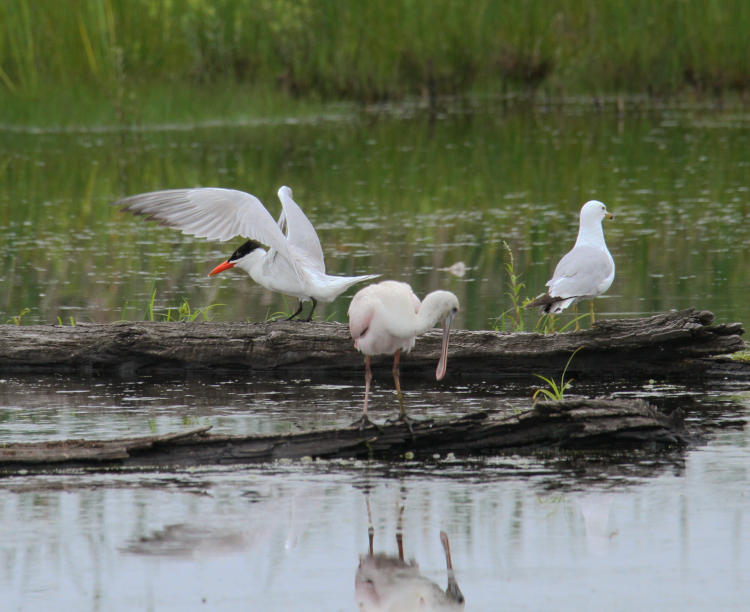
The other players here are a Caspian tern (Hydroprogne caspia,) which is rare enough in the area and a decent find all by itself, and a common-as-muck herring gull (Larus argentatus) – the unlikely criminal investigative trio. The scale is deceptive, because none of these are small birds, all massing much larger than crows. There was also a black tern wheeling overhead in its hyperactive feeding circuits, which I’d seen on the previous trip too, but snagging a decent photo proved as difficult this time as it did the last.
Oh, yeah, let’s get a look at that heron sculpture, near the visitor center.

This was a solid four or more meters tall, much taller than life size, and very well done, by sculptor James Seaman – he also has a huge bald eagle sculpture visible from both the wildlife drive and the interstate. Excellent work.

We didn’t drive through the Refuge this day, since it was pouring off and on, but The Girlfriend wanted some detailed shots of the sculpture and we had a little time to kill before a nearby winery opened (we obtained some excellent, authentic New York wine from Montezuma Winery – I’m not much for wine, or any alcohol really, but this is good stuff.) The close examination allowed us to realize there was a nest within, and thus the video clips, so serendipity there.
And now on to some things not in the video.

I had seen plenty of sandhill cranes (Antigone canadensis) in Florida and always considered them a southern bird, but it appears their range does include all of New York, so not shocking to see a pair here. They actually had a chick with them, and I was endeavoring to catch a glimpse of it at a great distance before I realized, on my return home, that one of the pair (the one with the muted coloration) was the chick, at adult size and ready to fly. That is, of course, not the one seen here – I couldn’t get the damn lens to lock on and remain sharp for anything.

Just mallards (Anas platyrhynchos,) a female (second from left) and four nearly full-grown chicks, deep in the reeds and trying to be subtle, though it would have worked better if they’d been quiet.

I’m fairly certain this is a female common yellowthroat (Geothlypis trichas,) which is slightly unfortunate because the male has the cooler coloration, but I certainly saw no sign of one. Or I could have misidentified this… but naahh, no one would believe that.

I don’t need to tell anyone these are Canada geese, almost despised as much as seagulls in some places though I’ve never seen the fuss, myself. To give an idea of how many were breeding here, beside the fact that half of those pictured here are chicks, when the breeze came across the marsh flats immediately behind the geese here, the only smell that carried was goose shit. It was impressive, though not exactly pleasant.
One of the real finds came soon after these, though.
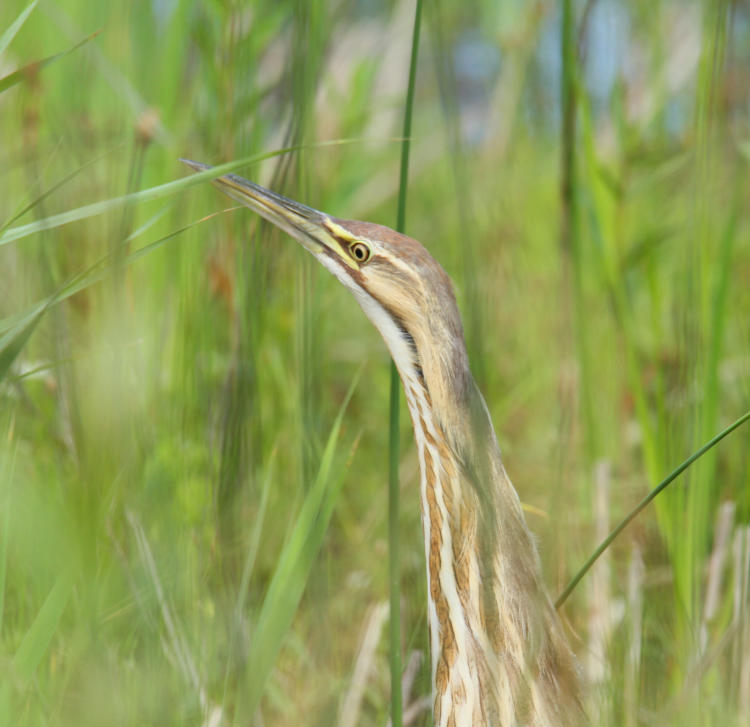
I’ve only seen American bitterns (Botaurus lentiginosus) maybe four times, and one of those was during a visit to the very same refuge in, like, 2009. They’re pretty well camouflaged normally, but if they suspect that they’re being observed (as this one soon did,) they drop their heads and slip through the reeds almost magically, disturbing nothing as they dodge among the stalks. That previous time, I managed to track it for a short ways, but this one vanished from all sight, leaving me with only three frames. That was the first visit to the refuge on the first trip to NY this year, and I watched carefully on all subsequent visits but saw no further sign of one.
And now, for a handful of images not from the Refuge – these are from the grounds of the Gatsby mansion where we stayed.
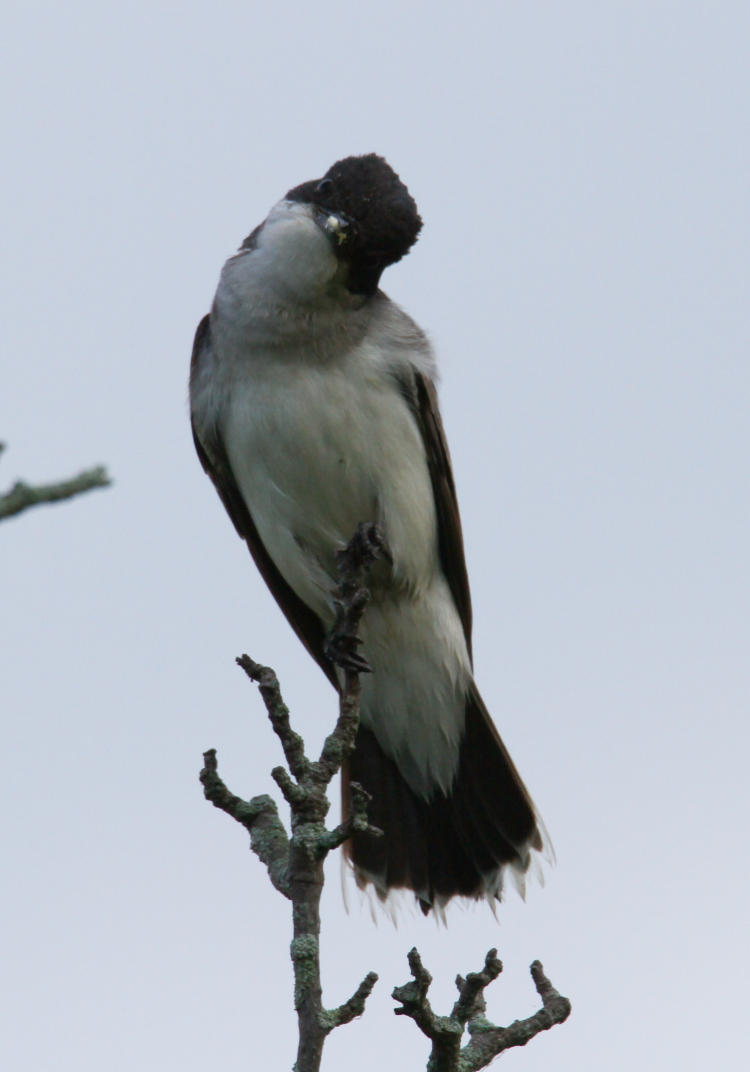
The behavior of a pair of kingbirds as I drew close to this tree clued me in to the nest that was within, which was pretty well hidden and completely silent. Since both parents were off the nest and watching warily, that gave some indication that there were young and not eggs within, but I saw and heard no sign of them, Nonetheless, I shot a few frames of the nest from different angles for closer examination later.

Yep, there’s a couple of beaks just barely peeking above the edge of the nest, when the right angle is achieved. We can get a closer look.
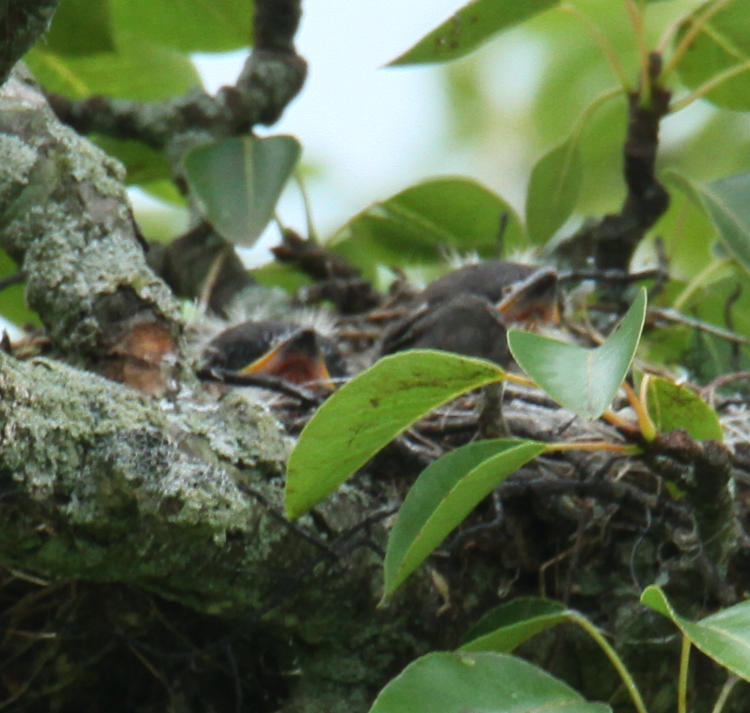
Nary a peep from them, but then again, the folks weren’t handy with food either. As I found out from my brother a day later, though, they did not escape the attention of a kestrel, who apparently made off with one of the young. Unfortunate, but that’s the balance of nature; I’m sorry I missed it myself, since that’s the kind of behavior that I try to capture, and it’s been a long time since I’ve seen a kestrel – they’ve gotten scarce around here.
Down near the lakeshore, I was picking a leaf off of a bush with brilliant translucent orange berries when something exploded almost out from under my hand. Let’s take a look from only two meters off.

I have just determined that this is a tatarian honeysuckle (Lonicera tatarica) bush, and the nest is right there in front of you. It’s easy to see why I missed it, but yeah, intrepid nature boy should have spotted it before I almost put my hand on it. It took a couple of attempts later on to capture the mother on the nest before she flew off.
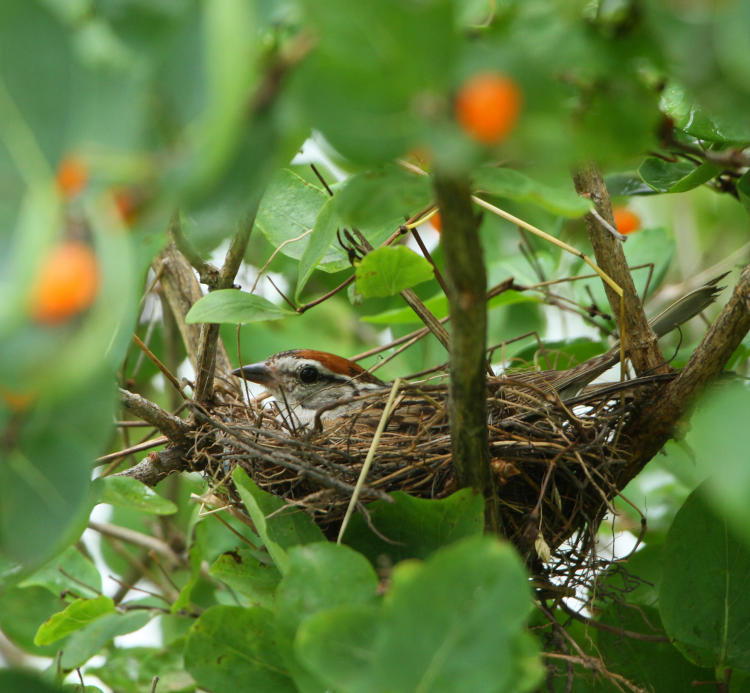
That ‘rufous’ crown pegs this as a chipping sparrow (Spizella passerina,) and I would have thought July was a bit late to still be sitting eggs, but this is central NY – the lake water was still a bit chilly for swimming (not that that stopped me.) I was just trying to get her to come up sharp, but the berries added a nice touch to the frame.
Okay, so that’s, what, 24 photos, 16 species, and a video? That’s enough for now, and catches me up a little bit. As I said, two more videos are in the works as well as quite a few more photos, so I got content to spare for a little while, even if I don’t shoot anything for a week (and that’s not likely to occur.) Will probably be another record-setting year.




















































